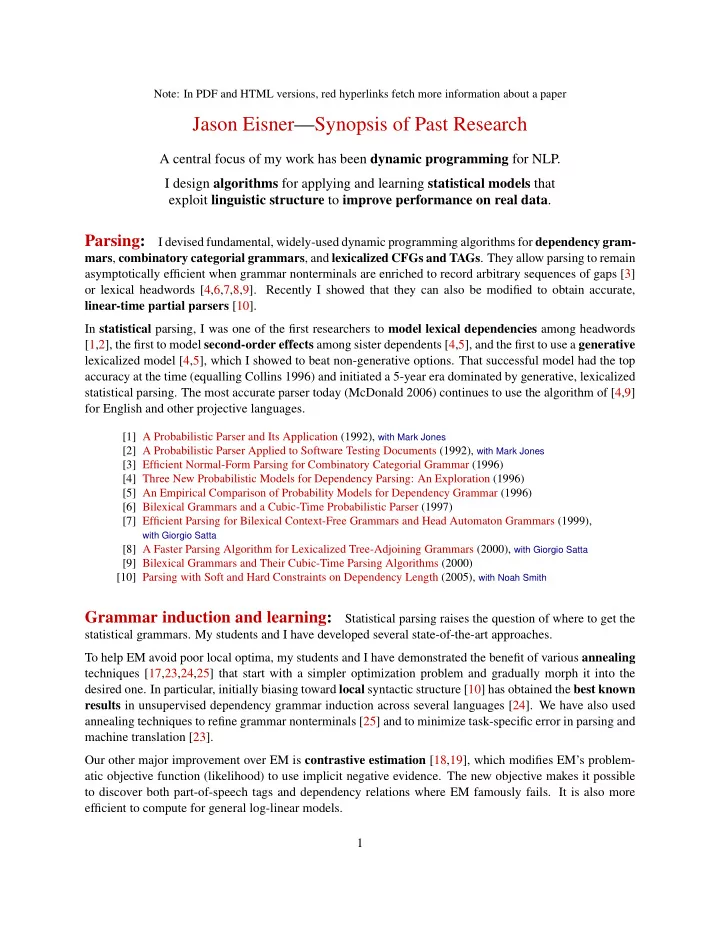

Note: In PDF and HTML versions, red hyperlinks fetch more information about a paper Jason Eisner—Synopsis of Past Research A central focus of my work has been dynamic programming for NLP. I design algorithms for applying and learning statistical models that exploit linguistic structure to improve performance on real data . Parsing: I devised fundamental, widely-used dynamic programming algorithms for dependency gram- mars , combinatory categorial grammars , and lexicalized CFGs and TAGs . They allow parsing to remain asymptotically efficient when grammar nonterminals are enriched to record arbitrary sequences of gaps [3] or lexical headwords [4,6,7,8,9]. Recently I showed that they can also be modified to obtain accurate, linear-time partial parsers [10]. In statistical parsing, I was one of the first researchers to model lexical dependencies among headwords [1,2], the first to model second-order effects among sister dependents [4,5], and the first to use a generative lexicalized model [4,5], which I showed to beat non-generative options. That successful model had the top accuracy at the time (equalling Collins 1996) and initiated a 5-year era dominated by generative, lexicalized statistical parsing. The most accurate parser today (McDonald 2006) continues to use the algorithm of [4,9] for English and other projective languages. [1] A Probabilistic Parser and Its Application (1992), with Mark Jones [2] A Probabilistic Parser Applied to Software Testing Documents (1992), with Mark Jones [3] Efficient Normal-Form Parsing for Combinatory Categorial Grammar (1996) [4] Three New Probabilistic Models for Dependency Parsing: An Exploration (1996) [5] An Empirical Comparison of Probability Models for Dependency Grammar (1996) [6] Bilexical Grammars and a Cubic-Time Probabilistic Parser (1997) [7] Efficient Parsing for Bilexical Context-Free Grammars and Head Automaton Grammars (1999), with Giorgio Satta [8] A Faster Parsing Algorithm for Lexicalized Tree-Adjoining Grammars (2000), with Giorgio Satta [9] Bilexical Grammars and Their Cubic-Time Parsing Algorithms (2000) [10] Parsing with Soft and Hard Constraints on Dependency Length (2005), with Noah Smith Grammar induction and learning: Statistical parsing raises the question of where to get the statistical grammars. My students and I have developed several state-of-the-art approaches. To help EM avoid poor local optima, my students and I have demonstrated the benefit of various annealing techniques [17,23,24,25] that start with a simpler optimization problem and gradually morph it into the desired one. In particular, initially biasing toward local syntactic structure [10] has obtained the best known results in unsupervised dependency grammar induction across several languages [24]. We have also used annealing techniques to refine grammar nonterminals [25] and to minimize task-specific error in parsing and machine translation [23]. Our other major improvement over EM is contrastive estimation [18,19], which modifies EM’s problem- atic objective function (likelihood) to use implicit negative evidence. The new objective makes it possible to discover both part-of-speech tags and dependency relations where EM famously fails. It is also more efficient to compute for general log-linear models. 1
For finite-state grammars, I introduced the general EM algorithm for training parametrically weighted regular expressions and finite-state machines [12,13], generalizing the forward-backward algorithm [14]. When context-free grammar rules can be directly observed (in annotated Treebank data), I have developed a statistical smoothing method, transformational smoothing [11,15,16], that models how the probabilities of deeply related rules tend to covary. It discovers this linguistic deep structure without supervision. It also models cross-lexical variation and sharing, which can also be done by generalizing latent Dirichlet allocation [22]. Recently I proposed strapping [20], a technique for unsupervised model selection across many runs of bootstrapping. Strapping is remarkably accurate; it enables fully unsupervised WSD to beat lightly super- vised WSD, by automatically selecting bootstrapping seeds far better than an informed human can (in fact, typically it picks the best seed of 200). I am now working on further machine learning innovations to reduce linguistic annotation cost, a major bottleneck in real-world applications. [11] Smoothing a Probabilistic Lexicon Via Syntactic Transformations (2001) [12] Expectation Semirings: Flexible EM for Finite-State Transducers (2001) [13] Parameter Estimation for Probabilistic Finite-State Transducers (2002) [14] An Interactive Spreadsheet for Teaching the Forward-Backward Algorithm (2002) [15] Transformational Priors Over Grammars (2002) [16] Discovering Syntactic Deep Structure via Bayesian Statistics (2002) [17] Annealing Techniques for Unsupervised Statistical Language Learning (2004), with Noah Smith [18] Contrastive Estimation: Training Log-Linear Models on Unlabeled Data (2005), with Noah Smith [19] Guiding Unsupervised Grammar Induction Using Contrastive Estimation (2005), with Noah Smith [20] Bootstrapping Without the Boot (2005), with Damianos Karakos [21] Unsupervised Classification via Decision Trees: An Information-Theoretic Perspective (2005), with Karakos et al. [22] Finite-State Dirichlet Allocation: Learned Priors on Finite-State Models (2006), with Jia Cui [23] Minimum-Risk Annealing for Training Log-Linear Models (2006), with David Smith [24] Annealing Structural Bias in Multilingual Weighted Grammar Induction (2006), with Noah Smith [25] Better Informed Training of Latent Syntactic Features (2006), with Markus Dreyer Machine translation: Extending parsing techniques to MT, one would like to jointly model the syntactic structure of an English sentence and its translation. I have designed flexible models [26,27,28] that can handle imprecise (“free”) translations, which are often insufficiently parallel to be captured by synchronous CFGs (e.g. ITGs). A far less obvious MT-parsing connection emerges from the NP-hard problem of reordering the source- language words in an optimal way before translation. I have developed powerful iterated local search algorithms for such NP-hard permutation problems (as well as classical NP-hard problems like the TSP) [29]. The algorithms borrow various parsing tricks in order to explore exponentially large local neighbor- hoods in polytime. Multilingual data is also used in some of my other recent work and that of my students [10,20,23,24,61,62,63]. [26] Learning Non-Isomorphic Tree Mappings for Machine Translation (2003) [27] Natural Language Generation in the Context of Machine Translation (2004), with Hajiˇ c et al. [28] Quasi-Synchronous Grammars: Alignment by Soft Projection of Syntactic Dependencies (2006), with David Smith [29] Local Search with Very Large-Scale Neighborhoods for Optimal Permutations in Machine Translation (2006), with Roy Tromble 2
Recommend
More recommend